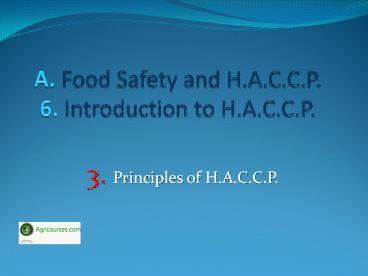Lecture 3: Principles of H.A.A.C.P. - PowerPoint PPT Presentation
1 / 10
Title:
Lecture 3: Principles of H.A.A.C.P.
Description:
This lesson put emphasis on food safety requirements, pathogenic microorganisms and foods, basic rules for food preparation, staff obligations, food contamination and staff, food safety hazards, advantages of H.C.C.C.P. – PowerPoint PPT presentation
Number of Views:47
Slides: 11
Provided by:
Username withheld or not provided
Category:
How To, Education & Training
Tags:
Title: Lecture 3: Principles of H.A.A.C.P.
1
A. Food Safety and H.A.C.C.P.6. Introduction to
H.A.C.C.P.
3. Principles of H.A.C.C.P.
2
HACCP principles
- Principle 1 Conduct a hazard analysis
- Principle 2 Determine the critical control
points (CCPs) - Principle 3 Establish critical limits (CL)
- Principle 4 Establish monitoring procedures
- Principle 5 Establish corrective actions
- Principle 6 Establish verification procedures
- Principle 7 Establish record-keeping and
documentation procedures
3
Principle 1 Conduct a hazard analysis
- The purpose of this principle is to develop a
list of hazards which are of such significance
that they are reasonably likely to cause injury
or illness if not effectively controlled. This
process involves two stages 1) hazard
identification, and 2) hazard evaluationDuring
the first stage, a list is developed of the
potential biological, chemical or physical
hazards that may be introduced, increased, or
controlled at each step in the production process - In stage two, the HACCP team then decides which
potential hazards must be addressed in the HACCP
plan. Each potential hazard is evaluated based on
the severity of the potential hazard and its
likely occurrence
4
Principle 2 - Determine Critical Control Points
(CCPs)
- A critical control point (CCP) is defined as a
step at which control can be applied and is
essential to prevent or eliminate a food safety
hazard or reduce it to an acceptable level - Examples of CCP's may include thermal processing,
chilling, testing ingredients for chemical
residues, product formulation control, and
testing product for metal contamination - Critical control points must be carefully
developed and documented and must be used only
for purposes of product safety
5
Principle 3 - Establish Critical Limits
- A critical limit is a maximum and/or minimum
value to which a biological, chemical or physical
parameter must be controlled at a critical
control point (CCP) to prevent, eliminate or
reduce to an acceptable level of occurrence of a
food safety hazard - A critical limit is used to distinguish between
safe and unsafe operating conditions at a CCP.
Critical limits must be scientifically based. - The critical limits and criteria for food safety
may be derived from sources such as regulatory
standards and guidelines, literature surveys,
experimental results, and experts
6
Principle 4 - Establish Monitoring Procedures
- Monitoring is a planned sequence of observations
or measurements to assess whether a critical
control point is under control and to produce an
accurate record for future use in
verification. Monitoring serves three main
purposes. - First, monitoring is essential to food safety
management in that it facilitates tracking of the
operation. If monitoring indicates that there is
a trend towards loss of control, then action can
be taken to bring the process back into control
before a deviation from a critical limit
occurs.Second, monitoring is used to determine
when there is a loss of control and a deviation
occurs at a CCP. When a deviation occurs, an
appropriate corrective action must be taken. - Third, it provides written documentation for use
in verification. Ideally, monitoring should be
continuous, which is possible with many types of
physical and chemical methods (i.e. temperature
or pH levels).
7
HACCP Principle 5 - Establish Corrective Actions
- Where there is a deviation from established
critical limits, corrective actions are necessary - Corrective actions is to prevent foods which may
be hazardous from reaching customers. - Corrective actions should include the following
elements a) determine and correct the cause of
non-compliance,b) determine the disposition of
non-compliant product, andc) record the
corrective actions that have been taken
8
Principle 6 - Establish Verification Procedures
- Verification is defined as those activities,
other than monitoring, that determine the
validity of HACCP plan and that the system is
operating according to the plan - One aspect of verification is evaluating whether
the HACCP system functions according to the
written HACCP procedures - Information needed for validation of the HACCP
plan often include1) expert advice and
scientific studies and 2) in-plant observations,
measurements, and evaluations - 3) Support documentation such as HACCP plan
review, verification and validation records. 4)
Records that are generated during the operation
of the HACCP system
9
Principle 7 - Establish Record Keeping and
Documentation Procedures
- The records maintained for a HACCP system should
include the following - 1. A summary of the hazard analysis, including
the rationale for determining hazards and control
measures. 2. The HACCP Plan
10
Summary of 3rd Lecture
- Principles of H.A.C.C.P.































